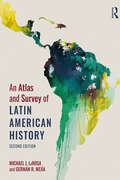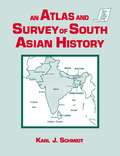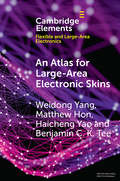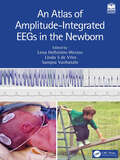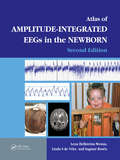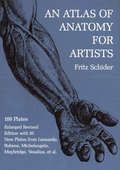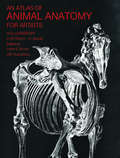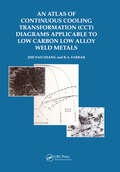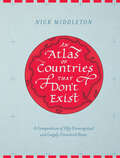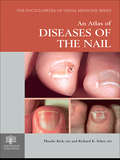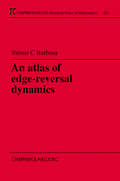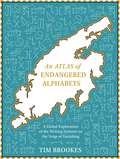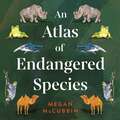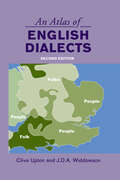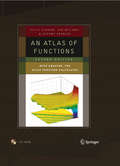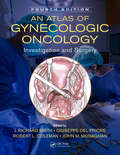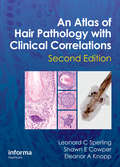- Table View
- List View
An Atlas Of Love: The Rupa Romance Anthology
by Anuja ChauhanAn Atlas of Love, edited by celebrated bestselling author Anuja Chauhan, is an anthology of romantic shorts that daringly explores the many guises of romance, from its purest form to its darkest depths. ‘Phoenix Mills’ takes you through a young man’s anguished quest for love; ‘Post-Coital Cigarette’ makes you flinch at a married man’s interpretation of love; and ‘Jilted’ shows you that love can also be courageous. You will find yourself in the middle of a torrid liaison in ‘The Affair’, revel in the euphoria of budding romance in ‘Just One Glance’ and discover what it means to let go of your loved one in ‘The Impasse’. Love can also be brutal and unconventional as ‘The Unseen Boundaries of Love’ and ‘Something about Karen’ will show you. But most of all, as ‘Death of a Widower’ and ‘Siddharth’ show, you will see that love is all about hope and taking the leap of faith. Selected from a nationwide Romance Contest conducted by Rupa Publications, this heart-warming collection of stories urges you to believe that love is eternal…and forever.
An Atlas and Manual of Coronary Intravascular Ultrasound Imaging
by Paul SchoenhagenIntravascular ultrasound (IVUS) is an imaging technique used during coronary angiography. This book provides a systematic introduction to coronary imaging with (IVUS). It is divided into two integrated and extensively cross-referenced parts, the Atlas and the Manual. The Manual describes the rationale, method, and interpretation of IVUS imaging for
An Atlas and Survey of Latin American History
by Michael LaRosa German R. MejiaAn Atlas and Survey of Latin American History provides a comprehensive, accessible introduction to both the human and physical geography of Latin America and the social, cultural, political and economic events that have defined its history. Featuring 77 maps and accompanying text, the book provides topical overviews of the key developments and movements in Latin American history, ranging from the earliest human settlement to the present day. The fully updated second edition includes a new chapter on Latin America in the 21st century, featuring maps and essays on topics ranging from sports and telenovelas to the growth of the Latin American middle class and the rise and ebb of left-leaning political movements. Highly readable and beautifully designed, An Atlas and Survey of Latin American History 2e remains an engaging resource for students and others interested in Latin American history, politics, and culture.
An Atlas and Survey of South Asian History (Sources And Studies In World History Ser.)
by Karl J. SchmidtThis historical atlas is devoted primarily to India, Bangladesh and Pakistan, while also covering Napal, Bhutan and Ceylon/Sri Lanka. The maps are accompanied by text which illuminates recent political, economic, social and cultural developments.
An Atlas for Large-Area Electronic Skins: From Materials to Systems Design (Elements in Flexible and Large-Area Electronics)
by Weidong Yang Matthew Hon Haicheng Yao Benjamin C. TeeElectronic skins are critical for many applications in human-machine-environment interactions. Tactile sensitivity over large areas can be especially applied to prosthetics. Moreover, the potential for wearables, interactive surfaces, and human robotics have propelled research in this area. In this Element, we provide an account and directional atlas of the progress in materials and devices for electronic skins, in the context of sensing principles and skin-like features. Additionally, we give an overview of essential electronic circuits and systems used in large-area tactile sensor arrays. Finally, we present the challenges and provide perspectives on future developments.
An Atlas for Staging Mammalian and Chick Embryos
by H. ButlerFor the convenience of research workers, particularly those with limited knowledge of embryology, we have put together a series of tables to enable rapid identification of specific stages of embryonic development in the more commonly used mammals. Because if its frequent usage the chick embryo is included this atlas.
An Atlas of Amplitude-Integrated EEGs in the Newborn
by Lena Hellström-Westas Linda S de Vries Sampsa Vanhatalo Sonia L Bonifacio Mohamed El-Dib Kathi Salley Randall Geraldine BoylanThis new edition updates the definitive clinical atlas textbook on interpreting continuous amplitude-integrated electroencephalography monitoring in neonatal units. It presents a comprehensive instructive overview linking tracings, scans, neuroimaging, real-time tracing clips, and detailed clinical scenarios and is an invaluable guide to all those needing to learn how to use aEEG for the best and safest results. An online quiz is available to enhance training and performance.This third edition of the aEEG atlas summarizes the experience and evidence of more than 40 years of aEEG monitoring in the newborn and also addresses the development and future of brain monitoring.
An Atlas of Amplitude-Integrated EEGs in the Newborn
by Lena Hellström-Westas Linda S. De Vries Ingmar RosenThoroughly revised from analogue examples to digital examples using simultaneous dual channel EEG, An Atlas of Amplitude-Integrated EEGs in the Newborn is the definitive clinical atlas-textbook on interpreting Cerebral Function Monitor (CFM) tracings. This simplified method of continuous amplitude-integrated EEG (EEG) mo
An Atlas of Anatomy for Artists: 189 Plates: Enlarged Revised Edition with 85 New Plates from Leonardo, Rubens, Michelangelo, Muybridge, Vesalius, et al. (Dover Anatomy for Artists)
by Fritz SchiderIn this expanded edition of a classic work, Schider's complete, historical text is accompanied by a wealth of anatomical illustrations. A variety of plates showcasing master artists -- including Leonardo, Rubens, Michelangelo, Muybridge, and Vesalius -- and their classic works on anatomy are also included. Features 593 illustrations.
An Atlas of Animal Anatomy for Artists (Dover Anatomy for Artists)
by Francis A. Davis W. EllenbergerEasy-to-follow instructions accompany 288 detailed, accurate illustrations of horses, dogs, cats, lions, cattle, deer, and other creatures. Each animal is depicted in a full external view as well as in beneath-the-skin drawings of musculature and skeletal structure. This classic reference has been enlarged with plates from the works of Stubbs, Straus-Durckheim, and Cuvier and Laurrillard.
An Atlas of Atopic Eczema
by Lionel FryAtopic eczema is the most common and persistent dermatological condition seen in general practice. Over the last few years, advances have been made in the genetics of atopy in general, newer treatments have been introduced for topical use, and new concepts suggested in the etiology. Thus, a new text on atopic eczema is both timely and useful. Writt
An Atlas of Cat Anatomy
by Hazel E. Field Mary E. TaylorAn Atlas of Cat Anatomy can help a student learn twice as much as he could in the same amount of time using only a written description. The book is spiral bound and stands like an easel, taking a minimum amount of space in the work area. Altogether there are fifty-seven plates featuring the various parts and organ systems in their actual size, making identification remarkably easy. A brief verbal description accompanies each plate. In addition, the extensive glossary includes synonymous terms, derivations, definitions, and keys to pronunciation.
An Atlas of Continuous Cooling Transformation (CCT) Diagrams Applicable to Low Carbon Low Alloy Weld Metals
by Zhuyo ZhangThis atlas is a collection of continuous cooling transformation diagrams applicable to low carbon low alloy weld metals. It will be of assistance to welding engineers, welding metallurgists, welding-consumables designers in industry.
An Atlas of Countries That Don't Exist: A Compendium of Fifty Unrecognized and Largely Unnoticed States
by Nick MiddletonA “fascinating” journey to little-known and contested lands around the globe, from Tibet to the Isle of Man to Elgaland-Vargaland (Geographical Magazine).What is a country? Acclaimed travel writer and Oxford geography don Nick Middleton brings to life the origins and histories of fifty states that, lacking international recognition and United Nations membership, exist on the margins of legitimacy in the global order. From long-contested lands like Crimea and Tibet to lesser-known territories such as Africa’s last colony and a European republic that enjoyed independence for a single day, Middleton presents fascinating stories of shifting borders, visionary leaders, and “forgotten” peoples. “Engrossing . . . You’ll not find Middle-earth, Atlantis or Lilliput inside, but you will find something just as intriguing . . . sure to prompt discussions about what makes a country a ‘real country.’” —Seattle Times
An Atlas of Diseases of the Nail (The\encyclopedia Of Visual Medicine Ser.)
by Richard K. Scher Phoebe RichDiseases of the nail represent a surprisingly large section of most dermatologists' practice - and can present difficult, sometimes intractable, clinical problems. Co-authored by one of the world's foremost authorities in the field, An Atlas of Diseases of the Nail provides expert and authoritative guidance on all aspects of diagnosis and managemen
An Atlas of Edge-Reversal Dynamics (Chapman & Hall/CRC Research Notes in Mathematics Series)
by V.C. BarbosaThis important resource offers the first in-depth account of the graph dynamics system SER (Scheduling by Edge Reversal),. In Part 1: Edge-Reversal Dynamics, the author discusses the main applications and properties of SER, provides data from statistics and correlations computed over several graph classes, and gives an overview of the algorithmic aspects of the construction of the catalogue. Part 2: The Atlas comprises the atlas proper-a catalogue of graphical representations of all basins of attraction generated by the SER mechanism for all graphs in selected classes.
An Atlas of Endangered Alphabets: Writing Systems on the Verge of Vanishing
by Tim BrookesA global exploration of the many writing systems that are on the verge of vanishing, and the stories and cultures they carry with them.If something is important, we write it down. Yet 85% of the world's writing systems are on the verge of vanishing - not granted official status, not taught in schools, discouraged and dismissed.When a culture is forced to abandon its traditional script, everything it has written for hundreds of years - sacred texts, poems, personal correspondence, legal documents, the collective experience, wisdom and identity of a people - is lost.This Atlas is about those writing systems, and the people who are trying to save them. From the ancient holy alphabets of the Middle East, now used only by tiny sects, to newly created African alphabets designed to keep cultural traditions alive in the twenty-first century: from a Sudanese script based on the ownership marks traditionally branded into camels, to a secret system used in one corner of China exclusively by women to record the songs and stories of their inner selves: this unique book profiles dozens of scripts and the cultures they encapsulate, offering glimpses of worlds unknown to us - and ways of saving them from vanishing entirely.
An Atlas of Endangered Alphabets: Writing Systems on the Verge of Vanishing
by Tim BrookesA global exploration of the many writing systems that are on the verge of vanishing, and the stories and cultures they carry with them.If something is important, we write it down. Yet 85% of the world's writing systems are on the verge of vanishing - not granted official status, not taught in schools, discouraged and dismissed.When a culture is forced to abandon its traditional script, everything it has written for hundreds of years - sacred texts, poems, personal correspondence, legal documents, the collective experience, wisdom and identity of a people - is lost.This Atlas is about those writing systems, and the people who are trying to save them. From the ancient holy alphabets of the Middle East, now used only by tiny sects, to newly created African alphabets designed to keep cultural traditions alive in the twenty-first century: from a Sudanese script based on the ownership marks traditionally branded into camels, to a secret system used in one corner of China exclusively by women to record the songs and stories of their inner selves: this unique book profiles dozens of scripts and the cultures they encapsulate, offering glimpses of worlds unknown to us - and ways of saving them from vanishing entirely.
An Atlas of Endangered Species
by Megan McCubbinThree species vanish every hour. Our incredible world is at risk, and we all have a part to play in saving it.The diversity of life on earth is astounding, with each species perfectly adapted to its environment. Sharks can navigate the ocean using electromagnetic fields; sloths use algae as camouflage; albatross can fly for hours without beating their wings; and orca pods each have unique cultures and languages. But every hour, three species disappear. Our incredible world is at risk.Megan McCubbin reveals the stories of the scientists, rangers and conservationists who are fighting to save these extraordinary creatures from extinction. An Atlas of Endangered Species shows us that the battle is on for their survival - and we all have a part to play.'A call to arms for everyone' Steve Backshall'Joyful and heartbreaking, an inspiring celebration of some of our planet's most endangered species and those who champion them' - Dave Goulson, author of Silent Earth'A powerful, passionate plea for a wilder future' - Sophie Pavelle, author of Forget Me Not(P) 2023 Hodder & Stoughton Limited
An Atlas of Endangered Species
by Megan McCubbin'A call to arms for everyone' Steve BackshallThe diversity of life on earth is astounding, with each species perfectly adapted to its environment. Sharks can navigate the ocean using electromagnetic fields; sloths use algae as camouflage; albatross can fly for hours without beating their wings; and orca pods each have unique cultures and languages. But every hour, three species disappear. Our incredible world is at risk.Megan McCubbin reveals the stories of the scientists, rangers and conservationists who are fighting to save these extraordinary creatures from extinction. An Atlas of Endangered Species shows us that the battle is on for their survival - and we all have a part to play.'Joyful and heartbreaking, an inspiring celebration of some of our planet's most endangered species and those who champion them' - Dave Goulson, author of Silent Earth'A powerful, passionate plea for a wilder future' - Sophie Pavelle, author of Forget Me Not
An Atlas of English Dialects: Region and Dialect (Routledge Library Editions: The English Language Ser.)
by Clive Upton J.D.A WiddowsonDo you call it April Fools’ Day, April Noddy Day or April Gowkin’ Day? Is the season before winter the Autumn, the Fall or the Backend? When you’re out of breath, do you pant, puff, pank, tift or thock? The words we use (and the sounds we make when we use them) are more often than not a product of where we live, and An Atlas of English Dialects shows the reader where certain words, sounds and phrases originate from and why usage varies from region to region. The Atlas includes: ninety maps showing the regions in which particular words, phrases and pronunciations are used detailed commentaries explaining points of linguistic, historical and cultural interest explanations of linguistic terms, a bibliography for further reading and a full index. Based on the Survey of English Dialects – the most extensive record of English regional speech – the Atlas is a fascinating and informative guide to the diversity of the English Language in England.
An Atlas of Extinct Countries
by Gideon Defoe"Prisoners of Geography meets Bill Bryson: a funny, fascinating, beautifully illustrated—and timely—history of countries that, for myriad and often ludicrous reasons, no longer exist. “Countries are just daft stories we tell each other. They’re all equally implausible once you get up close.” Countries die. Sometimes it’s murder, sometimes it’s by accident, and sometimes it’s because they were so ludicrous they didn’t deserve to exist in the first place. Occasionally they explode violently. A few slip away almost unnoticed. Often the cause of death is either “got too greedy” or “Napoleon turned up.” Now and then they just hold a referendum and vote themselves out of existence. This is an atlas of 48 nations that fell off the map. The polite way of writing an obituary is: dwell on the good bits, gloss over the embarrassing stuff. This book refuses to do so, because these dead nations are so full of schemers, racists, and con men that it’s impossible to skip the embarrassing stuff. Because of this – and because treating nation-states with too much reverence is the entire problem with pretty much everything – these accounts are not concerned with adding to the earnest flag saluting in the world, however nice some of the flags might be."
An Atlas of Functions: with Equator, the Atlas Function Calculator
by Keith B. Oldham Jerome Spanier Jan MylandThis second edition of An Atlas of Functions, with Equator, the Atlas Function Calculator, provides comprehensive information on several hundred functions or function families, of interest to all those scientists, engineers and mathematicians who are concerned with the quantitative aspects of their field. Beginning with simple integer-valued functions, the book progresses to polynomials, exponential, trigonometric, Bessel, and hypergeometric functions, as well as many more. The 65 chapters are arranged roughly in order of increasing complexity, mathematical sophistication being kept to a minimum while utility is stressed throughout. In addition to providing definitions and simple properties for every function, each chapter catalogs more complex interrelationships as well as the derivatives, integrals, Laplace transforms and other characteristics of the function. Numerous color figures in 2 or 3 dimensions depict their shape and qualitative features and flesh out the reader's familiarity with the functions. In many instances, the chapter concludes with a concise exposition on a topic in applied mathematics associated with the particular function or function family. Features that make the Atlas an invaluable reference tool, yet simple to use, include: full coverage of those functions--elementary and "special"--that meet everyday needsa standardized chapter format, making it easy to locate needed information on such aspects as: nomenclature, general behavior, definitions, intrarelationships, expansions, approximations, limits, and response to operations of the calculusextensive cross-referencing and comprehensive indexing, with useful appendicesthe inclusion of innovative software--Equator, the Atlas Function Calculatorthe inclusion of new material dealing with interesting applications of many of the function families, building upon the favorable responses to similar material in the first edition.
An Atlas of Gynecologic Oncology: Investigation and Surgery, Fourth Edition
by Robert Coleman John Monaghan J. Smith Giuseppe PrioreThe latest edition of An Atlas of Gynecologic Oncology continues its coverage of the innovative techniques in investigation and surgery on the brink of becoming established as part of the gynecologic surgeon’s repertoire, now including the exciting developments in uterine transplantation.
An Atlas of Hair Pathology with Clinical Correlations
by Leonard C Sperling Shawn E. Cowper Eleanor A. KnoppDiagnosing and treating hair disorders is still a subject that is rarely or only superficially covered in residency training. Hence, dermatopathologists and clinical dermatologists often find a gap in their knowledge. A new edition of an acclaimed text, An Atlas of Hair Pathology with Clinical Correlations, Second Edition bridges this gap and serve


